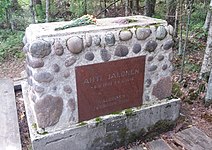-
A grain processing facility by the Turku–Uusikaupunki railway in Nousiainen
-
European route E8 in Nousiainen
-
The memorial of Ahti Jalonen (1901–1918), a young victim of the White Terror during the Finnish Civil War
-
Emovaha glacial erratic in Nousiainen
Nousiainen
Nousis | |
|---|---|
Municipality | |
| Nousiaisten kunta Nousis kommun | |
 Nousiainen Church | |
 Location of Nousiainen in Finland | |
| Coordinates: 60°36′N 022°05′E / 60.600°N 22.083°E | |
| Country | |
| Region | Southwest Finland |
| Sub-region | Turku sub-region |
| Charter | 1867 |
| Government | |
| • Municipal manager | Juhani Kylämäkilä |
| Area (2018-01-01)[1] | |
| • Total | 199.55 km2 (77.05 sq mi) |
| • Land | 198.93 km2 (76.81 sq mi) |
| • Water | 0.62 km2 (0.24 sq mi) |
| • Rank | 263rd largest in Finland |
| Population (2023-09-30)[2] | |
| • Total | 4,695 |
| • Rank | 176th largest in Finland |
| • Density | 23.6/km2 (61/sq mi) |
| Population by native language | |
| • Finnish | 96.9% (official) |
| • Swedish | 0.8% |
| • Others | 2.3% |
| Population by age | |
| • 0 to 14 | 19% |
| • 15 to 64 | 60.3% |
| • 65 or older | 20.6% |
| Time zone | UTC+02:00 (EET) |
| • Summer (DST) | UTC+03:00 (EEST) |
| Climate | Dfb |
| Website | www.nousiainen.fi |
Nousiainen (Finnish: [ˈnou̯siˌɑi̯nen]; Swedish: Nousis) is a municipality of Finland. It is located in the Southwest Finland region, 20 kilometres (12 mi) from Turku along Highway 8 (E8).[6] The Finnish-speaking municipality has a population of 4,695 (30 September 2023)[2] and covers an area of 199.55 square kilometres (77.05 sq mi) of which 0.62 km2 (0.24 sq mi) is water.[1] The population density is 23.6 inhabitants per square kilometre (61/sq mi).
There are two Natura 2000 sites in Nousiainen: the Kurjenrahka National Park and the Rehtisuo Raised Bog.[7]






